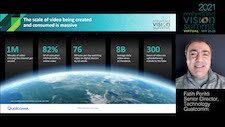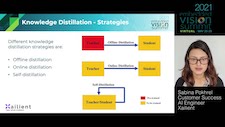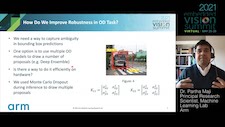| LETTER FROM THE EDITOR |
Dear Colleague,
The next Embedded Vision Summit will take place as a live event May 17-19 in Santa Clara, California. The Embedded Vision Summit is the key event for system and application developers who are incorporating computer vision and visual AI into products. It attracts a unique audience of over 1,000 product creators, entrepreneurs and business decision-makers who are creating and using computer vision and visual AI technologies. It’s a unique venue for learning, sharing insights and getting the word out about interesting new technologies, techniques, applications, products and practical breakthroughs in computer vision and visual AI. We’re delighted to return to being in-person and hope you’ll join us. Once again we’ll be offering a packed program with 100+ sessions, 50+ technology exhibits, and 100+ demos, all covering the technical and business aspects of practical computer vision, deep learning, visual AI and related technologies. And new for 2022 is the Edge AI Deep Dive Day, a series of in-depth sessions focused on specific topics in visual AI at the edge. Registration is now open, and if you register by this Friday, March 11, you can save 25% by using the code SUMMIT22-NL. Register now, save the date, and tell a friend! You won’t want to miss what is shaping up to be our best Summit yet. Next Thursday, March 17 at 9 am PT, Network Optix will deliver the free webinar “A Platform Approach to Developing Networked Visual AI Systems” in partnership with the Edge AI and Vision Alliance. Internet-connected cameras are becoming ubiquitous. Coupled with computer vision and machine learning algorithms, these cameras form the foundation for a growing range of visual AI applications that monitor people, facilities, and other objects and environments. But creating a robust, scalable application using internet-connected cameras requires much more than cameras and algorithms. For example, these applications typically need robust video storage management, including the ability to manage limited bandwidth, provisions for reliable recovery in the event of hardware failures and the ability to securely store video on a variety of device types. In addition, networked visual AI applications often must be able to discover and interact with a variety of camera and stream types on a network. They also typically require media servers and clients that can run on mobile, desktop, server and cloud. And they need extensibility –so that they can be integrated with a variety of existing software stacks, applications and ecosystems. Network Optix’s Nx Meta intelligent video platform enables solution developers to create cross-platform networked visual AI solutions that incorporate device and stream discovery and interoperability, robust storage management, and extensibility in a matter of weeks. In this webinar, Tony Luce, Vice President of Product Marketing at Network Optix, will introduce the NX Meta platform and describe examples of currently deployed applications utilizing the platform. A question-and-answer session also including Nathan Wheeler, Chairman and CEO of the company, will follow the presentation. For more information and to register, please see the event page. Brian Dipert |
| OPTIMIZING INFERENCE ACCURACY AND EFFICIENCY |
|
Efficient Video Perception Through AI Introduction to DNN Model Compression Techniques |
| OBJECT RECOGNITION WITH LIMITED AND EVOLVING TRAINING DATA |
|
Robust Object Detection Under Dataset Shifts High-fidelity Conversion of Floating-point Networks for Low-precision Inference Using Distillation with Limited Data |
| UPCOMING INDUSTRY EVENTS |
|
A Platform Approach to Developing Networked Visual AI Systems – Network Optix Webinar: March 17, 2022, 9:00 am PT Embedded Vision Summit: May 17-19, 2022, Santa Clara, California |
| FEATURED NEWS |
|
FRAMOS’ New Sensor Module Targets Demanding 4K/60 FPS Applications Intel Advances AI Inferencing for Developers via a New Version of OpenVINO Basler Expands Its 3D Portfolio with a Stereo Camera Series SmartCow AI Technologies’ Apollo Development Kit Enables Conversational and Other Advanced Natural Language Processing Applications Immervision Launches a SDK Supporting Universal Web Video Dewarping |
| WHO’S HIRING |
|
Mashgin (Software Engineer, Computer Vision and Deep Learning) |







